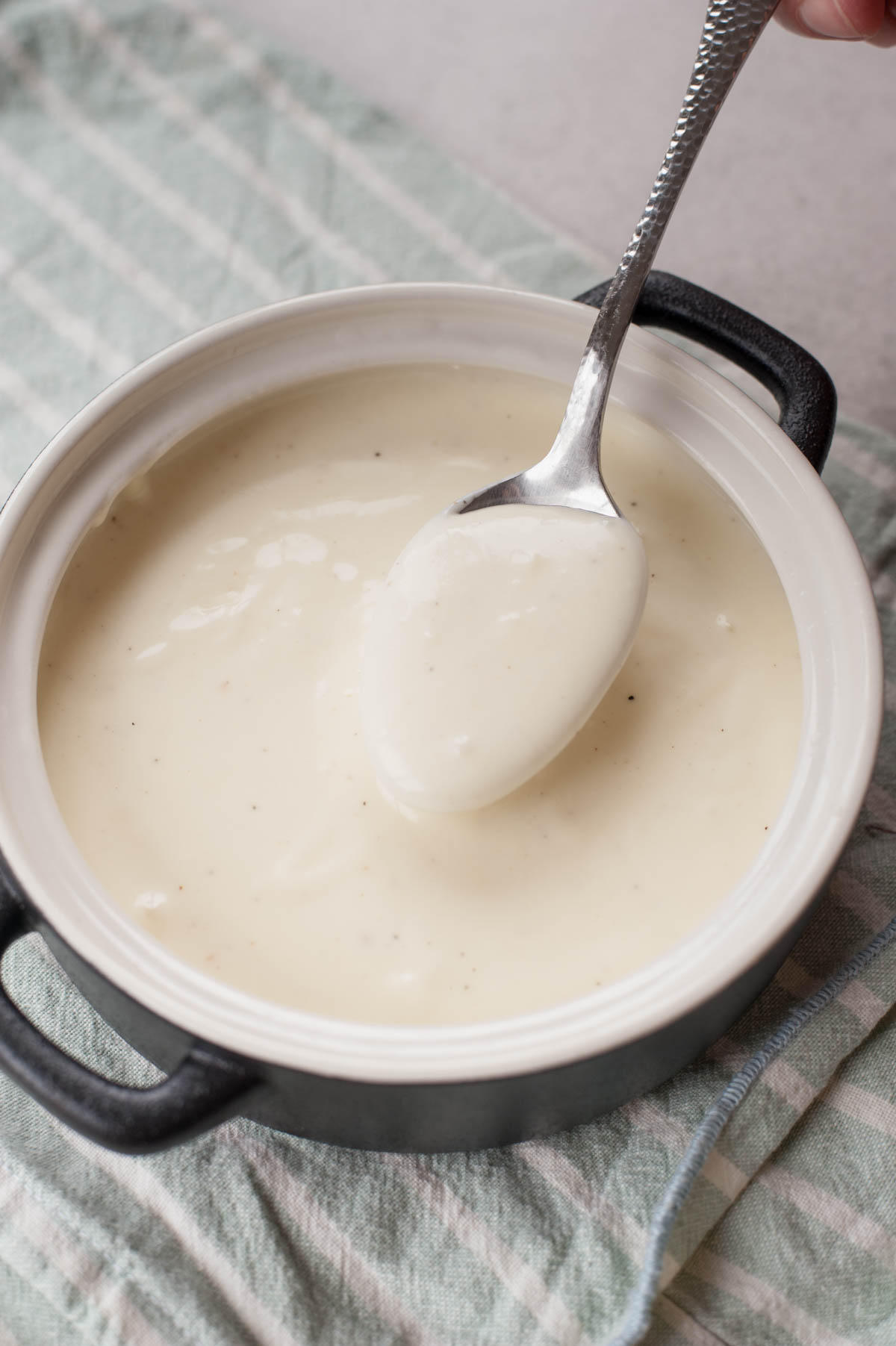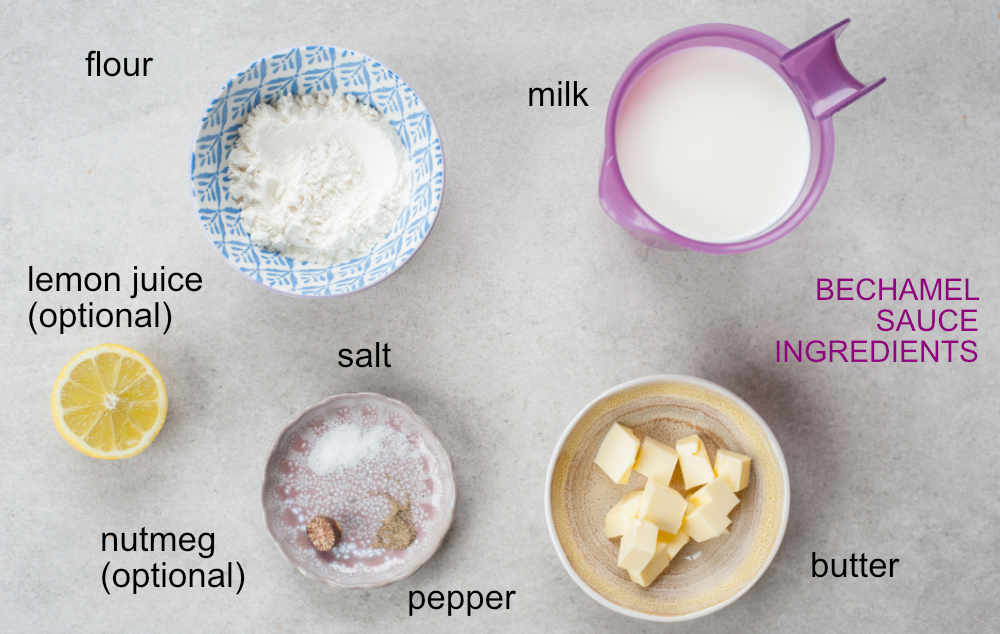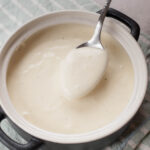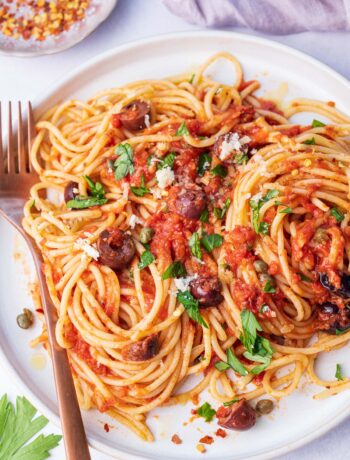Bechamel sauce, sometimes also called the white sauce, is considered one of the French/Italian basic sauces. It can be served alone, as a sauce served with fish or asparagus, or be a part of more complex dishes like lasagna or make a base for other sauces like cheese sauce or alfredo sauce. It’s very easy and quick to make, it consists of only 3 main ingredients! This is the easiest and foolproof recipe that will result in a creamy and smooth white sauce.

History of the sauce:
Béchamel sauce is one of the five French “mother sauces”. The others are: velouté, éspagnol, hollandaise, and tomat (here you’ll find a great infographic showing all the mother sauces). The sauce is originally of Italian origin (called Besciamella in Italian) and immigrated from Tuscany to France, where was easily adapted into the rich French cuisine. They renamed it after the chief steward to King Louis XIV, the marquis de Bechamel, and quickly found a number of delicious recipes to adapt it into.
There are actually two versions of bechamel sauce. A classic French version which is rather time-consuming calls for clarified butter, sauteing onions, a long cooking process (30-45min) and straining the sauce through cheesecloth. If you’re curious, the recipe is here. Modern recipes are simplifying the process.
Ingredients:

- The basic recipe consists of only 3 main ingredients: butter, flour, milk, and additionally salt and black pepper.
- Note about the pepper – some chefs prefer to use white pepper so that you won’t see specks of black pepper in the white sauce. I don’t mind that. If you want to use white pepper remember it’s more powerful than black pepper so just use less.
- I’m also adding freshly grated nutmeg – this seasoning works best with the white sauce. You can use already ground nutmeg or grate it yourself (on a microplane or nutmeg grater) which is a better option.
- In my recipe, there’s also a very unusual ingredient – just a little lemon juice. You won’t see this ingredient in any traditional bechamel sauce recipes, but I’m telling you, the sauce is so good with it. This sauce can really taste plain but the lemon juice just brightens it up and adds freshness, it won’t taste lemony though. You can easily omit it, it’s not necessary, just something that I really love to add.
- Other ingredients you could use:
- some French recipes call for infusing the sauce with onion, bay leaves, and clove. You can use the clove as a drawing pin and pin the bay leaf to the onion. Add these three to the sauce to infuse it with the flavor, then take out at the end. This is called oignon piqué in French.
- you could use bacon or sausage fat instead of butter for an extra meat flavor.
- if you’ve run out of butter, this recipe uses olive oil instead of butter
- this article from Cook’s Illustrated uses skimmed milk for a lighter sauce.
- some herbs to infuse the sauce: like thyme.
- you can also just go completely wild and make an amazingly rich, fluffy mushroom bechamel, by adding eggs to it and mushroom cooking water, just like it did in this recipe: white lasagna with pumpkin and mushrooms.
Ingredient ratios:
I’ve tried all the possible ingredients ratios and these are my observations. The authentic French recipes call for the same amounts of flour to butter by weight. My recipe calls for a 1:1 ratio by volume simply because this bechamel is more foolproof. When you add more butter, it coats the flour better and reduces the chance of a clumpy sauce. I’m adding 2 Tbsp of butter and flour for 1 cup of milk. The truth is, you can make a good bechamel sauce from any recipe that is on the internet, just some of the recipes are more foolproof and some less. But really one thing that can happen is a small amount of tiny clumps in your sauce which is really not that tragic in my opinion. The flour to milk ratios also vary, this will only make your sauce thicker on thinner. In this recipe for white lasagna (lasagna made with only white sauce and no red sauce), I’m adding more flour for 1 cup of milk than here, simply because I don’t want to cook the sauce, I want it to be instantly thick and ready to pour over the lasagna noodles because the lasagna preparation is already long enough.
Sauce consistency:
Bechamel sauce can be made in three thicknesses: thin, medium-thin and thick. This will depend on the amount of flour per cup of milk.
- Thin sauce is used as a base for creamy soups, to serve with fish, or as a light vegetable topping.
- Medium-thin sauce is most versatile – is used as a base for a variety of other sauces.
- Thick bechamel is used to make a souffle, or a moussaka.
Recipe variations:
- Bechamel sauce forms the base for a number of other classic sauces like Mornay (shredded cheese is added), Nantua (shrimp butter and heavy cream are added), Mustard (mustard and cream are added), Soubise (is made with sauteed onions), Cheddar Cheese Sauce (with shredded cheddar), Aurore (tomato paste is added), Chivry (with herbs and white wine), and others.
- How to make cheese sauce: it’s best to add cheeses that melt well such as parmesan, gruyere, fontina or cheddar. Add 1 cup of any of these cheeses of a mix of them to the recipe below. A touch of mustard and cayenne pepper would also taste great. You may want to try my beer cheese sauce or pumpkin mac and cheese which are basically bechamel sauce with cheese and other spices added.
How to make it step by step:

STEP 1: Melt 4 Tbsp of butter in a big frying pan or a wide pot.
STEP 2: When it’s bubbling add 4 Tbsp of flour.

STEP 3: Mix the butter and flour with a wooden spoon until they form a thick paste (this is called a roux). Cook, stirring, for about a minute over low heat to cook out the raw taste of the flour.
Don’t let the paste brown – it should be yellow in color. If you’ve browned your butter you need to start over (the taste of the sauce will be completely different).
STEP 4: Add about 1/3 cup of milk and whisk vigorously until the milk has been completely absorbed by the flour-butter paste.
If you’re a beginner or have had troubles with bechamel sauce, sieve the flour before adding it and warm up the milk (should be very warm, but not boiling).

STEP 5 (photos 5 and 6): Keep adding the remaining milk (2 cups in total), in 1/3-1/2 cup amounts. Whisk thoroughly after each addition and wait until the milk is combined with the sauce. Mix vigorously especially at the beginning, to make sure that no lumps form.
If you’re more advanced you can add the milk, all at once, in a thin stream to the butter-flour paste and whisk until a smooth sauce is created. Cook for a couple of minutes until thickened.

STEP 6: Cook the sauce for 2-5 minutes on the lowest heat until thickened. It should coat the back of a spoon and it should not feel grainy when a small amount of sauce is rubbed between your fingers. Keep in mind that the sauce will still thicken after taking the pot off the heat.
Remove the pot from the heat. Season with salt, pepper, nutmeg and lemon juice (if using). Use immediately.
What to do if something goes wrong:
The sauce is clumpy: Use a hand blender or regular blender to puree the sauce or push it through a fine-mesh strainer.
If the sauce is too thick: add some milk and whisk vigorously to combine.
If the sauce is too thin: simmer it down – the sauce will thicken quickly or cook a little more flour and butter in a small saucepan on the side, then whisk it into your sauce. Just remember that any bechamel will thicken very quickly after you take the pot off the heat. It always needs to be thinner than you plan to, because it will thicken.
Storage:
The sauce can be stored in the fridge for up to 3 days and reheated. You need to cover the sauce with a plastic foil, the foil should touch the surface of the sauce to prevent the forming of a skin. I personally don’t like to place a plastic foil over a hot sauce (health reasons) so a usually just leave the sauce to cool slightly, then stir it thoroughly with a whisk and then cover with plastic foil and refrigerate.
How to reheat bechamel sauce: The cooled sauce will be very thick and resemble a pudding. If you want to reheat it, warm it up slowly over low heat and add some milk to dilute it. Whisk vigorously to make the sauce smooth. It’s possible that it won’t as smooth as freshly made so I wouldn’t serve it as one of the most important ingredients of a dish (like a sauce for fish or asparagus), but if you want to incorporate it into another dish, for example, make a cheese sauce or a lasagna, this won’t be a problem.
Freezing:
Can bechamel sauce be frozen? Surprisingly the answer is yes. Thaw it in the fridge then reheat. The sauce will curdle, but you can just mix it with a blender and its consistency will be smooth again. You may need to thin it a bit with milk.
Recipe uses:
Bechamel sauce is used to make so many dishes. Many of them may be familiar to you, but you can be unaware that their base is bechamel sauce.
- pasta sauces: mac and cheese, alfredo sauce
- casseroles: lasagna – regular lasagna and also white lasagna that is many only with the white sauce, moussaka, au gratin potatoes, au gratin cauliflower
- white pizza (white sauce instead of tomato sauce)
- chicken pot pie
How to make bechamel sauce – an easy and foolproof recipe
Ingredients
- 4 tablespoons butter 2 oz/60g
- 4 tablespoons flour 1.4 oz/40g
- 2 cups whole milk 480-500ml
- big pinch of nutmeg optional
- 1 teaspoon lemon juice optional
- salt and black pepper to taste
Would you like to save this?
Instructions
- Melt the butter in a big frying pan or a wide pot. When it’s bubbling add the flour.
- Mix the butter and flour with a wooden spoon until they form a thick paste. Cook, stirring, for about a minute over low heat. Don’t let the paste brown (it should be yellow in color).
- Add about 1/3 cup of milk and whisk vigorously until the milk has been completely absorbed by the flour-butter paste.
- Keep adding the remaining milk, in 1/3-1/2 cup amounts. Whisk thoroughly after each addition and wait until the milk is combined with the sauce. Mix vigorously especially at the beginning, to make sure that no lumps form.
- Cook the sauce for 2-5 minutes on the lowest heat until thickened. Keep in mind that the sauce will still thicken after taking the pot off the heat.
- Remove the pot from the heat. Season with salt, pepper, nutmeg and lemon juice (if using). Use immediately.
Notes
- If you’re more advanced you can add the milk, all at once, in a thin stream to the butter-flour paste and whisk until a smooth sauce is created. Cook for a couple of minutes until thickened.
- Cook the sauce over low heat.
- If you’re a beginner or have had troubles with bechamel sauce, sieve the flour before adding it and warm up the milk (should be very warm, but not boiling).
- Ingredients:
- Pepper – if you don’t want black specks of black pepper in your sauce, use white pepper. Just remember that it’s more powerful than black pepper so just use less.
- Nutmeg and lemon juice are optional.
- other ingredients you can use: you can infuse the sauce (or just milk) with 1/4 of an onion, 1 clove, and 1 bay leaf, you can warm up the milk with these spices and add warm spiced milk to the roux.
- Storage: The sauce can be stored in the fridge for up to 3 days and reheated. You need to cover the sauce with a plastic foil, the foil should touch the surface of the sauce to prevent the forming of a skin. I personally don’t like to place a plastic foil over a hot sauce (health reasons) so a usually just leave the sauce to cool slightly, then stir it thoroughly with a whisk and then cover with plastic foil and refrigerate.
- How to reheat bechamel sauce: The cooled sauce will be very thick and resemble a pudding. If you want to reheat it, warm it up slowly over low heat and add some milk to dilute it. Whisk vigorously to make the sauce smooth. It’s possible that it won’t as smooth as freshly made so I wouldn’t serve it as one of the most important ingredients of a dish (like a sauce for fish or asparagus), but if you want to incorporate it into another dish, for example, make a cheese sauce or a lasagna, this won’t be a problem.
- What to do if something goes wrong:
- The sauce is clumpy: Use a hand blender or regular blender to puree the sauce or push it through a fine-mesh strainer.
- If the sauce is too thick: add some milk and whisk vigorously to combine.
- If the sauce is too thin: simmer it down – the sauce will thicken quickly or cook a little more flour and butter in a small saucepan on the side, then whisk it into your sauce. Just remember that any bechamel will thicken very quickly after you take the pot off the heat. It always needs to be thinner than you plan to, because it will thicken.






6 Comments
Gerry
22 January 2023 at 14:25Do you know if I can make this ahead of time and freeze it?
Aleksandra
22 January 2023 at 15:23The answer is yes and yes. If you scroll up a bit (above the recipe card) there is a whole section where I explain how to store/reheat and freeze the sauce.
JOHN Moss
29 November 2022 at 15:14That’s the first time I’ve made a white sauce so that I could make Mac”n”Cheese from scratch and it came out perfect! 10/10.Im really proud of myself. I’ve always been a good cook as when I got my first flat at 23yrs old I was determined not to live off packet food or chips! I’m good at cooking Jamaican food so going to cook the Jamaican version of Mac”n”Cheese, also I’m gunna have a go at another fav of mine Alfredo Chicken. Thanks for the recipe, it’s was clear & really easy to read!
Aleksandra
29 November 2022 at 19:04I´m glad it worked out for you!
Linda Czuba
7 February 2021 at 02:23Flavorful and rich tasting, yet light! Delicious on pasta and with soft pretzels!
Aleksandra
7 February 2021 at 06:27I’m glad you liked the recipe, thank you for commenting!